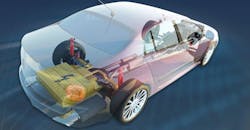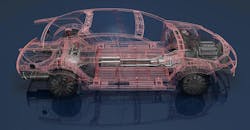Kevin Anderson, senior analyst at IHS Markit, says the average number of advanced driver-assistance systems (ADAS) installed in vehicles, including blind-spot information, adaptive cruise control, lane-departure warning, rear automatic braking, and other features joining the now ubiquitous backup cameras, will grow from an average of 1.6 per vehicle today to 3.8 in 2023.
ADAS automate, adapt, and enhance vehicle systems for safety and better driving. The automated system, which is provided by ADAS to the vehicle, is proven to reduce road fatalities by minimizing the human error. Safety features are designed to avoid collisions and accidents by offering technologies that alert the driver to potential problems, or avoid collisions by implementing safeguards and taking over control of the vehicle. Adaptive features may automate lighting, provide adaptive cruise control, automate braking, incorporate GPS/ traffic warnings, connect to smartphones, alert driver to other cars or dangers, provide lane-departure warnings and/or automatic lane centering, or show what is in blind spots.
ADAS is one of the fastest-growing segments in automotive electronics, with steadily increasing rates of adoption of industry-wide quality standards. These include ISO 26262 for vehicular safety systems, developing technology-specific standards like IEEE 2020 for Image Sensor quality, and communications protocols such as the Vehicle Information API.
Next-generation ADAS will increasingly leverage wireless network connectivity to offer improved value by using car-to-car (also known as vehicle-to-vehicle, or V2V) and car-to-infrastructure (also known as vehicle-to-infrastructure, or V2X) data.
Power Semiconductors
Growth in number of power inverters, converters, chargers, and auxiliary systems in the powertrain segment will lead to a 10% compound annual growth rate (CAGR) for powertrain modules between 2017 and 2023. In terms of revenue, power ICs in those systems will grow at a CAGR of 9%, power discretes will increase 11%, and power modules will rise 32%.
Unit shipments of power semiconductors for infotainment units are expected to grow 7%, as car buyers increasingly value the ability to connect to their smartphones and other mobile devices. Body and convenience and chassis and safety unit shipments are forecast to grow at a modest 4% growth rate, since many of these systems are already standard features in most vehicles.
According to IHS Markit, average growth in power semiconductor revenue and unit shipments will largely be led by burgeoning sales of ADAS and electrified powertrains. In fact, ADAS unit shipments are expected to grow at a CAGR of 17% from 2017 through 2023, due to expanding new car assessment program (NCAP) coverage of active safety features, as well as growing consumer demand for advanced safety features in all vehicle segments.
Mild and full hybrid vehicles and electric vehicles (EVs) are expected to comprise 28% of the total light vehicle market in 2023, up from 4% today, according to IHS Markit forecasts. This automotive category growth will lead to an increase in the use of powertrain power semiconductors, causing revenue in this segment to grow at a 13% CAGR from 2017 through 2023.
In a 2017 report, IHS said that discrete power semiconductors provide the highest average value per car. This isn’t surprising as they have the lowest average sales price and are used in even the simplest, cheapest automotive electronic systems like engines, transmission control units, electrified oil pumps, and power systems.
The 2017 report also said that power ICs provide slightly less average value per car. They’re more expensive and newer, so are more prevalent in high-end vehicles and more modern car designs, which contain a greater array of features like ADAS. Power modules have the smallest average value per car because their use is restricted to larger, high-end vehicles and to hybrid and electric vehicles.
Lifecycle and Design Factors
Unit growth is only one of the factors influencing the demand for automotive power semiconductors. Lifecycle and design trends also have a big impact on the device types used in these types of systems.
Automotive-systems production progresses through a design lifecycle of development, optimization, and maturity. During the development phase, known off-the-shelf components are typically used to minimize development risk. Once the optimization and maturity phases are reached, cost reduction is a high priority, and components with higher integration are usually developed to achieve size, cost, and power savings.
The standard for functional safety applied to automotive systems, ISO 26262, is another key factor in component selection. Meeting safety goals is crucial to many automotive systems, especially those operating autonomously and others providing driver assistance. Achieving safety goals often requires additional redundancy, runtime diagnostics, fault notification, and other features added to the system.
Due to all of these factors, application-specific ICs (ASICs), system basis chips (SBCs), power-management ICs (PMICs), and other highly integrated devices are projected to grow faster than standalone single-function power ICs like linear voltage regulators and switching converters.
The IHS report covers 30 power semiconductor device types and 35 automotive electronics systems. The forecast was built from the bottom up, starting with vehicle build and electronic module fitment projections. A power semiconductor bill-of-materials was then created for each system, using the IHS Markit teardown database, supplier interviews, and analyst expertise to create a by-system, by-component forecast in both units and dollars.
Automotive Putting SiC on the Road
In another report, Power SiC report, 2018 edition, Yole Développement (Yole) asserts that the silicon-carbide (SiC) power market is now showing up on the road. Since 2017, the market research and strategy consulting company identified more than 20 strategic announcements, showing the dynamism of this market and attractiveness of the technology. Rohm, Bombardier, Cree, SDK, STMicroelectronics, Infineon Technologies, Littelfuse, Ascatron, and more are part of the powerful ecosystem, presenting innovative products and revealing key partnerships and/or M&A.
Today, SiC transistors are clearly being adopted, penetrating smoothly into different applications. Yole’s analysts forecast a US$1.4 billion SiC power semiconductor market by 2023. According to the Power & Wireless team at Yole, this market shows a 29% CAGR between 2017 and 2023.
Yole’s understanding of SiC penetration in different applications includes xEV, xEV charging infrastructure, power factor correction (PFC)/power supply, photovoltaics (PV), UPS, motor drives, wind, and rail. In addition, it highlights the state-of-the-art SiC-based devices, modules, and power stacks. Yole’s analysts also describe the SiC power industrial landscape from materials to systems, and analyze of SiC power market dynamics. This report proposes a detailed quantification of the SiC power device market until 2023, in value and volume.
SiC adoption is accelerating, but is the supply chain ready? Yole’s analysts reveal that SiC market is still being driven by diodes used in PFC and PV applications. However, they expect that five years from now, the main SiC device market driver will be transistors, with an impressive 50% CAGR for 2017-2023.
This adoption is partially due to the improvement of the transistor performance and reliability compared to the first generation of products, which gives confidence to customers for implementation.
Another key trend revealed by Yole’s analysts is the SiC adoption by automotive players, over the next 5-10 years. “Its implementation rate differs depending on where SiC is being used,” comments Dr. Hong Lin, Technology and Market Analyst, Compound Semiconductors at Yole. “That could be in the main inverter, in OBC [on-board charging], or in the dc-dc converter. By 2018, more than 20 automotive companies are already using SiC SBDs [Schottky barrier diodes] or SiC MOSFET transistors for OBC, which will lead to 44% CAGR through to 2023.”
Yole expects SiC adoption in the main inverter by some pioneers, with an inspiring 108% market CAGR for 2017-2023. This will be possible because nearly all carmakers have projects to implement SiC in the main inverter in coming years. In particular, Chinese automotive players are strongly considering the adoption of SiC.
The recent SiC module developed by STMicroelectronics for Tesla and its Model 3 is a good example of this early adoption. The SiC-based inverter, analyzed by System Plus Consulting, Yole’s sister company, is composed of 24 1-in-1 power modules. Each module contains two SiC MOSFETs with an innovative die-attach solution. The module connects directly on the terminals with copper clips and is thermally dissipated by copper baseplates. Thermal dissipation of the modules is performed thanks to a specifically designed pin-fin heatsink.
“SiC MOSFET is manufactured with the latest STMicroelectronics technology design,” explains Dr. Elena Barbarini, Head of Department Devices at System Plus Consulting. “This technical choice allows reduction of conduction losses and switching losses.”
STMicroelectronics is strongly involved in the development of SiC-based modules for the automotive industry. During its recent Capital Markets Day, the company detailed its activities in this field (Source: Automotive & Discrete Group presentation – May 2018). STMicroelectronics is also committed in the development of innovative packaging solutions. System Plus Consulting proposes today a complete teardown analysis, including a detailed estimation of the production cost of the module and its package.
PV has also caught the attention of Yole’s analysts during recent months. China claimed almost the half of the world’s installations in the last year. However, due to new governmental regulations, Yole sees a slowdown of the PV market in short term and thus lowered its expectation of SiC penetration for the segment.
In general, system manufacturers are interested in implementing cost-effective systems that are reliable, without any technology choice, either silicon or SiC. “Today, even if it’s certified that SiC performs better than silicon, system manufacturers still get questions about long-term reliability and the total cost of the SiC inverter,” says Dr. Ana Villamor.
About the Author

Sam Davis
Sam Davis was the editor-in-chief of Power Electronics Technology magazine and website that is now part of Electronic Design. He has 18 years experience in electronic engineering design and management, six years in public relations and 25 years as a trade press editor. He holds a BSEE from Case-Western Reserve University, and did graduate work at the same school and UCLA. Sam was the editor for PCIM, the predecessor to Power Electronics Technology, from 1984 to 2004. His engineering experience includes circuit and system design for Litton Systems, Bunker-Ramo, Rocketdyne, and Clevite Corporation.. Design tasks included analog circuits, display systems, power supplies, underwater ordnance systems, and test systems. He also served as a program manager for a Litton Systems Navy program.
Sam is the author of Computer Data Displays, a book published by Prentice-Hall in the U.S. and Japan in 1969. He is also a recipient of the Jesse Neal Award for trade press editorial excellence, and has one patent for naval ship construction that simplifies electronic system integration.
You can also check out his Power Electronics blog.


